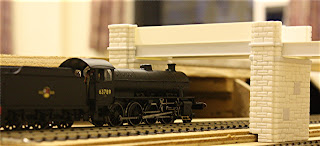Infrastructure
One of the main challenges for any model railway is making it all work. South Pelaw is a big layout (see posts from Jan 2012 introducing the project and progress), and so this is much more of a headache that it would be for a smaller project.We are, as ever, at the cutting edge of technology. Thanks largely to Martin Lloyd's enthusiasm, we have an embryonic layout where the signals and turnouts will be operated by servos, and be controlled using the MERG CBUS system.
In a nutshell, CBUS works a little like DCC in that a large number of signals, turnouts and relays for section switching can all be operated from a two wire bus. In theory, this reduces the amount of wiring needed. I'm sure the theory is correct, but the main control panel for the layout is nevertheless quite a complex beast. Here's another close-up picture of the wiring behind the panel.
Another part of the infrastructure that is essential, but hard to figure out has been the storage sidings or fiddle yard behind the layout. There are several complications. Bankers will need to be detached, cross over, and return back to South Pelaw. Iron ore should appear to come from Washington (usually, sometimes it came via Ouston if the Washington line was closed) on the outer loop, but then cross over to go up to Consett on the inner loop. Other traffics may also need to cross from one loop to the other. Coal and other loads going up the bank to Stanley and Consett will need to be split in to shorter cuts. There's a couple of photos on ironroad's smugmug site, which show K1 62060 doing just this. The complication for us is that in the fiddle yard, the loco will need to shunt the wagons, cross over, and return down the bank with the brake van ready for the next cut. This complexity means that the design and construction of the fiddle yard has lagged somewhat behind the front of the layout, and some parts are still templates. On a more positive note, we have managed to find a use for a scissors crossing that has been languishing in Richard Nice's garage for some years.
Much more pleasing to look at are the buildings that are starting to take shape. The signal boxes built by Mark Lloyd and Richard Nice have already appeared on the blog, but are now nearing completion and look simply superb.
We are very excited about the new Hornby O1, as a small number of these engines were fitted with air pumps in the 1950s, and together with Q7s handled the iron ore traffic until the arrival of the 9Fs.
The example above is straight out of the box, and is rather delicately balanced on the EM gauge track, as can be seen from the rather drunk tender.
As well as the signal boxes, the bridges are very important structures for the layout. The bridge at the Washington end (No. 1) was demolished about a year ago, but fortunately we had been able to photograph it extensively before this unhappy event. In the new year Pete unveiled the bridge piers, which are a hugely impressive bit of modelling. Embossed stone didn't quite capture what we were after, so Pete decided to carve them one by one. Fantastic.
Richard Clayton






